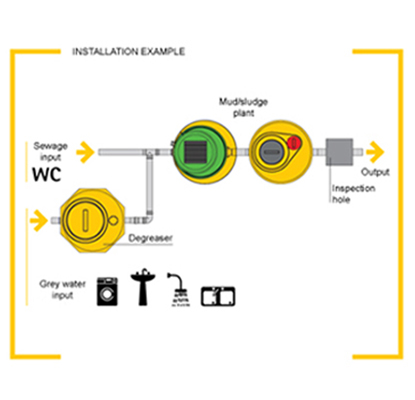Used Water Purification Plants
The active or "totally oxidized" sludge/mud plants are used for wastewater of domestic origin that are not discharged in the public drainage
system. This purifying method is biologic and is based on the action of aerobic bacterium that feed on the organic substances that is contained
in the deposited wastewater entrance. The active sludge plants are distributed in oxidation zones, and aerated by the necessary diffused air
that can be supported by the bacterium content, in an area of larger mud/sludge sediment aggregates, which are separated from the exit water
flow. These plants can furnished with pre/post treatments that will totally guarantee an overall and a better purification efficiency end
results, according to the functional characteristics of the final out flow discharged.
The active mud/sludge plants are particularly suitable for small and medium communities, as they offer the following advantages:
- Simplification of the type of treatment, with a consequent
reduction of the number of elements of plant parts and the financial fund investments necessary.
- The acquisition of a higher purifying standard and a constant
end results of flow treatment.
- The production of an elevated level of sludge/mud of biologic
stability and low level of plant maintenance needs.
- Low electric power consumption or without the need for
electricity for plants of smaller dimensions.
Eventual preparatory treatments:
- Measuring Stations: to guarantee a constant purification
result, a measuring plant station flow is used to control the pic flow periods (daily/weekly) capacity, which can cause a bad malfunctioning of the purifying process.
- Denitrification Compartment: the denitrification compartment
is always necessary whenever there is need to lower the concentration of nitrogen in the sludge/mud, (for example, when it is needed to discharge the flow on the terrain).
Eventual Post treatment:
- Mud/Sludge Inspection: the mud/sludge in excess is sent to
a gravitational inspection point, to realize a drastic reduction of the weight and volume of it.

Drinkable Water Treatment Procedures
Drinkable Water Treatment Procedures (or water purification) consist of the removal of contaminant waste residues from raw water with the scope
of obtaining an ideal water suitable for normal domestic consumption or for the irrigation of farmlands and for industries (for example: usage
by food production companies).
With the gradual reduction or diminution of the source of drinkable water (water from soil depths), there is always a recurring alternative
choice of superficial sources of water (from the sea, river streams, natural and artificial lakes).
These alternative water supply resources, in relation to their specific characteristics e/o pollution grades; must undergo a cycle of
treatments to enable a standard chemical modification and fixed residues determination for an ideal drinkable water quality.
Same occurs also for water from deep soil, with a high level of polluted microbic organic substances contents, where there are presence of
bacterium, originating from feces (example: colibacilium).
The purification is done by passing the raw water (from sea/river stream water or from lakes) through different organic and inorganic
filtering plants.
The removal methods used can be of physical nature, chemo-physical and biologic, in function of the types of natural and anthropic substances
presence to be eliminated during the water treatment analysis.
The first type comprises, for example:
- Iron and manganese: in water of deep soil origin;
- Hydrogen sulphate: in lower depth underground water origin;
- Sulphates: present in deep water source origin and in
thermal/volcanic activity zones
The second type comprises, for example:
- Heavy metals: antimony, arsenic, lead, in traceable
concentration from industrial wastes discharge;
- Organic micro pollutants: hydrocarbons, phyto-pharmacies
and solvents;
- Ammonium, nitrites and nitrates; etc.
In addition, raw water contains also a form of microbiologic life:
- Planktons;
- Benthos;
- Mycete;
- Protozoa;
- Bacterium (pathogens of environmental origin);
- Viruses
The procedure sequences of drinkable water treatment analysis to be followed must be programed to guarantee:
- Suitable organoleptic characteristics: taste, odor, color,
turbidity;
- Suitable characteristics, such as: temperature, electrical
conductivity and pH;
- Suitable bio-chemical characteristics, such as: the hardness,
salt contents ratio, micro pollutants, organic discharge, microbiologic life (the removal of pathogenic chemical substances (chlorine) that inhibits the growth of microorganisms);
N.B.: For an ideal and correct choice of the type of treat to be used (see the following paragraph) and as such, the type of water treatment
plant to be proposed; it is very important to effect a complete and profound analysis of the water to be treated.
VRB solution©






